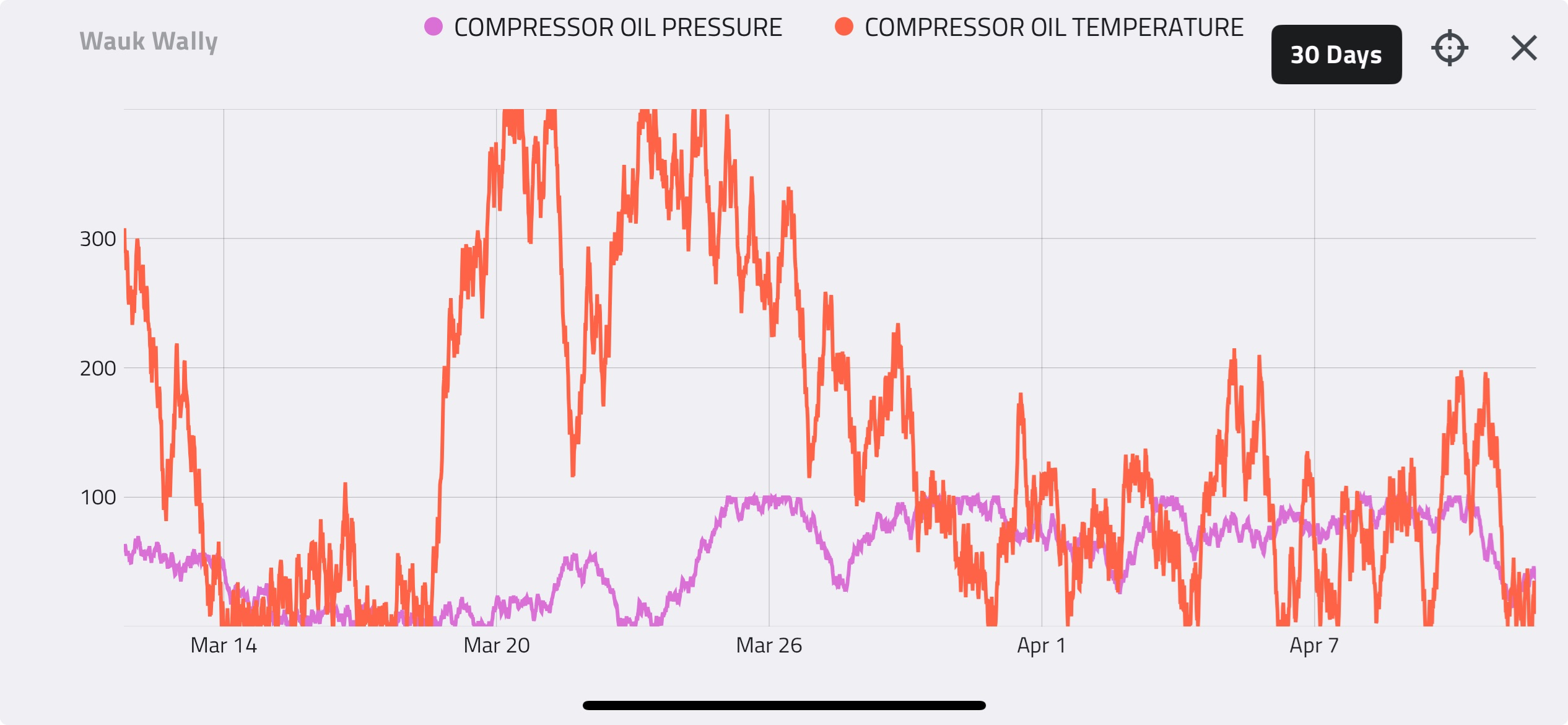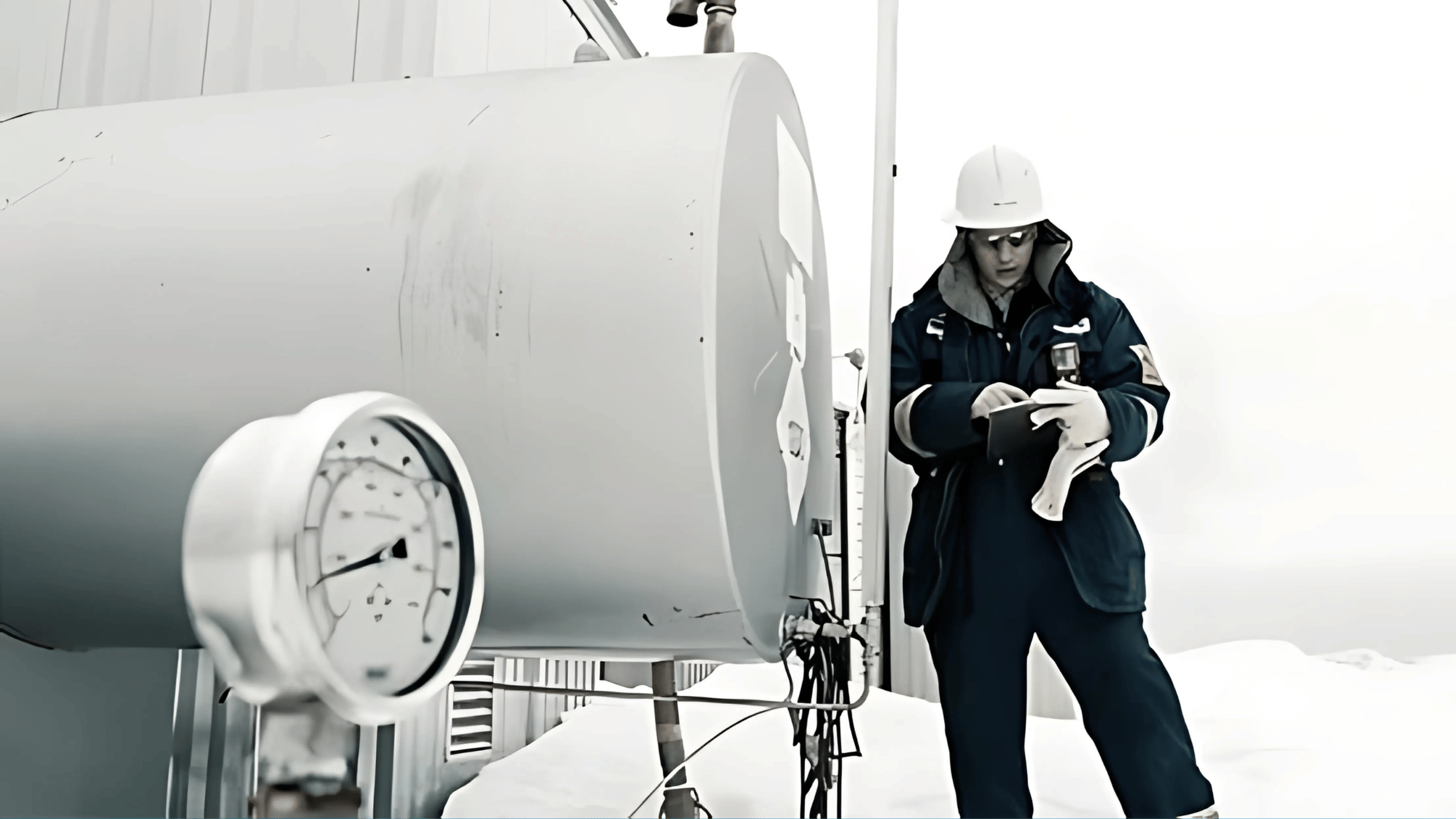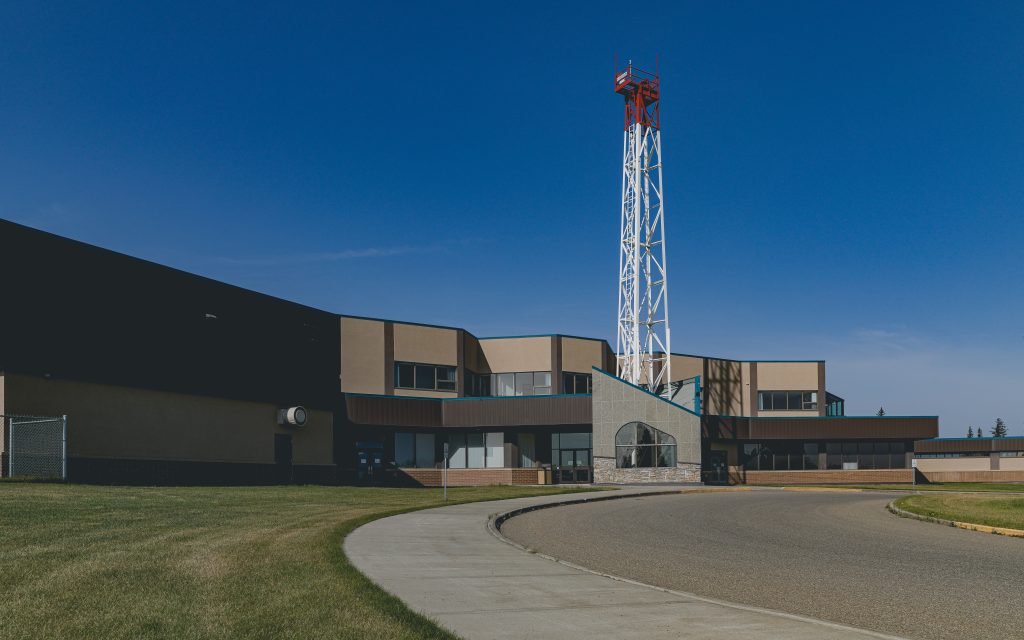Houston, TX |
“Gauge Maintenance” is the term used by Detechtion Technologies when the monitored compressor parameters are thermodynamically impossible according to the Enalysis software model. This occurs when the calculated expected discharge temperature is greater than the actual measured discharge temperature for a cylinder.
On a Blowby trend, Gauge Maintenance presents as negative Blowby. However, while Blowby represents an inefficiency in the compression process, Gauge Maintenance indicates that something is not as expected. It is important to troubleshoot Gauge Maintenance just as you would troubleshoot for causes of Blowby, as the cause of the Gauge Maintenance may mask other issues occurring within the compressor.
This E-Tip discusses the following main causes of a Gauge Maintenance flag on an Enalysis report:
- Faulty Sensors
- Changes in Gas Composition
- Changes in Valve Model or Lift
- Recycled Gas
- Water-Cooled Cylinders
Note that some of the causes of Gauge Maintenance can also be causes of Blowby.
Faulty Pressure or Temperature Sensor
The most frequent cause of Gauge Maintenance is an inaccurate pressure or temperature sensor. The trend below shows the result of an erratic Stage 1 suction temperature reading on the blowby calculation. When the suction temperature sensor reports a temperature higher than the temperature of the gas stream, the reported discharge temperature is likely to be less than thermodynamic ally possible. This will result in Gauge Maintenance flagging on the Enalysis report. Gauge Maintenance can similarly result from a faulty pressure sensor. Faulty sensors usually only result in Gauge Maintenance flagging on a specific cylinder or, at most, all cylinders on a specific stage of a compressor.
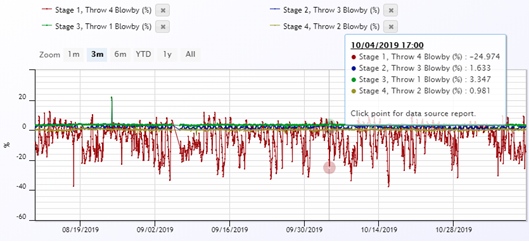
Other than causing inaccuracies in calculated values on the Enalysis report, the key issue with Gauge Maintenance is that it can mask an issue within the cylinder that would otherwise flag as Blowby. By the time the issue is flagged as high Blowby, it will be much more progressed in a cylinder that regularly flags Gauge Maintenance than in a cylinder with normal healthy levels of Blowby.
Changes in Gas Composition
Different gas compositions require a different amount of energy for compression and, therefore, result in different discharge temperatures for comparable operating conditions. Gases with lighter molecular weights (ie. predominately Methane) have a higher ratio of molar specific heat capacities and result in a higher discharge temperature. While gases with heavier molecular weights have a lower ratio of molar specific heat capacities and result in a lower discharge temperature.
The Blowby trend below is for a compressor that experiences large swings in the amount of C2H6 in the gas stream. Increasing amounts of C2H6 result in decreases in discharge temperature and cause Gauge Maintenance to flag.
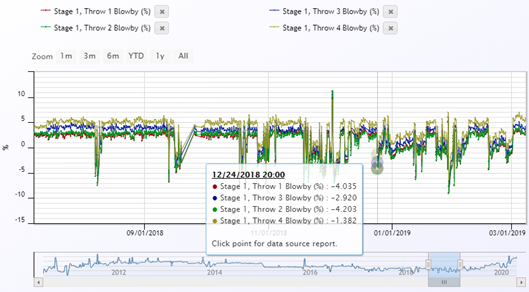
The gas composition through a compressor can also change over time as new wells are brought online or as the composition of depleting wells increases in molecular weight.
Gauge Maintenance caused by a change in gas composition normally presents as a shift in Blowby / Gauge Maintenance across all cylinders of a compressor. Changes in composition due to new wells or changing well composition can be corrected with an updated gas analysis in Enalysis. If operational requirements result in frequent changes in gas composition, it may be beneficial to create a calculated gas composition, which can then be updated automatically via Enalysis’ new Public Restful API.
Changes in Valve Model or Lift
Internal cylinder pressures must be calculated to determine the expected discharge temperature for each cylinder. Reported suction and discharge pressures are converted to internal pressures by the inclusion of all pressure losses from the pressure sensor location to the inside of the cylinder. One source of pressure loss is through the valves. Even when fully open, the valves act as a restriction to flow into and out of the cylinder, resulting in a pressure drop across the valve.
Changes in valve type, model or lift can affect the pressure drop across the valve. Valves that result in a lower pressure drop, result in a lower internal compression ratio and a lower discharge temperature. Therefore, if valves in a compressor are changed out for valves with a higher lift and higher flowing area, for example, Gauge Maintenance is likely to flag on the Enalysis report unless the compressor model in Enalysis is updated to reflect the new valve specifications.
If you feel that either Gauge Maintenance or Blowby may be the result of recent valve changes, send the new valve specifications to your Engineering Account Manager at Detechtion so that they can update the compressor model in Enalysis.
Recycled Gas
The location of the recycled gas return can also result in Gauge Maintenance flagging on an Enalysis report. The trend below shows the Blowby trends of a 3-Stage compressor. The Enalysis reports regularly flagged Gauge Maintenance on Stage 3 of this compressor, which presents as negative Blowby in the trend below. This compressor has a bypass valve that returns the recycled gas back to the suction of Stage 3 to maintain a desired Stage 3 suction pressure. The return of the recycled gas is downstream of the Stage 3 suction temperature sensor. When the cooler recycled gas mixes with the inlet gas, the comingled gas stream into the cylinder is significantly cooler than the temperature measured by the Stage 3 suction temperature sensor. Therefore, the measured discharge temperature is significantly lower than the expected discharge temperature calculated by Enalysis and Gauge Maintenance flags on the reports.
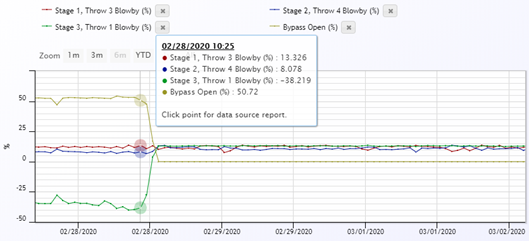
A new suction temperature sensor should be installed closer to the cylinder inlet and downstream of the recycle return. However, if this is not possible, then your EAM may be able to calculate an adjusted Stage 3 suction temperature based on the recycle valve position. When recording suction temperatures with an infrared temperature gun, ensure that all suction temperatures are taken downstream of any recycle returns and, ideally, on the piping leading into the suction pulsation bottle.
Water-Cooler Cylinders
Some compressors have water-cooled cylinders. The circulated water absorbs some of the heat of compression and results in lower discharge temperatures than would otherwise be possible. Therefore, with the underlying assumption of 0% Blowby being equivalent to perfect adiabatic compression, water-cooled cylinders will cause Gauge Maintenance to flag on an Enalysis report.
Water-cooled cylinders are accommodated in Enalysis by a cooling factor. Your EAM will be able to determine the appropriate cooling factor for your specific compressor cylinders.
E-Tip 1.8 will cover Detechtion Technologies’ recommended steps for troubleshooting Blowby and Gauge Maintenance flags on an Enalysis report. Click here to read it now.

